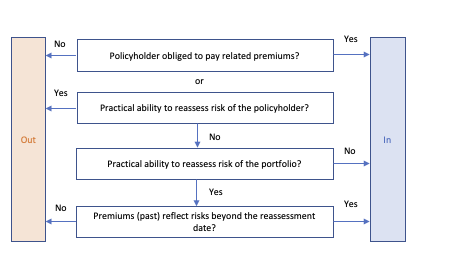
IFRS 17
2023 is a very important year for the insurance industry: The complex IFRS 17 framework was set in force on 1st January 2023 and replaces the interim standard IFRS 4 Phase I, which has been in force since 2005. The new standard regulates the principles for identification, recognition, measurement, presentation and disclosures for insurance contracts.
Alma is going to accompany the implementation of IFRS 17 by the insurance industry. Therefore, Alma will publish from time to time brief and well understandable articles on IFRS 17.
Part 7: Contract Boundary (CB)
The “contract boundaries” (CB) are central to the evaluation, just as the “units of accounts” are central to the evaluation. For the valuation, only the cash flows that are within the CB are to be taken into account.

For example, let us consider an insurance contract that has a term of one year, an expected combined ratio of 80% and a renewal option. Let us also assume for the purpose of simplification that each year 1/10 of the initial portfolio makes use of the renewal option and that the risk adjustment and interest are zero. In this case, an initial CSM (contractual service margin)
-
- of 20% of the premium, if renewals are not taken into account, and
- a huge CSM of 110% of the premium if renewals are taken into account.
Thus, each company is required to determine the CB for their groups, the rules for which are formulated as follows:
Cash flows are within the boundary of an insurance contract if they arise from substantive rights and obligations that exist during the reporting period in which the entity can compel the policyholder to pay the premiums or in which the entity has a substantive obligation to provide the policyholder with insurance contract services.
A substantive obligation to provide insurance contract services ends when:
(a) the entity has the practical ability to reassess the risks of the particular policyholder and, as a result, can set a price or level of benefits that fully reflects those risks; or
(b) both of the following criteria are satisfied:
(i) the entity has the practical ability to reassess the risks of the portfolio of insurance contracts that contains the contract and, as a result, can set a price or level of benefits that fully reflects the risk of that portfolio; and
(ii)the pricing of the premiums up to the date when the risks are reassessed does not take into account the risks that relate to periods after the reassessment date.
An entity shall not recognise as a liability or as an asset any amounts relating to expected premiums or expected claims outside the boundary of the insurance contract. Such amounts relate to future insurance contracts.
The following explanation can also be used as a guide for determining the CB:

